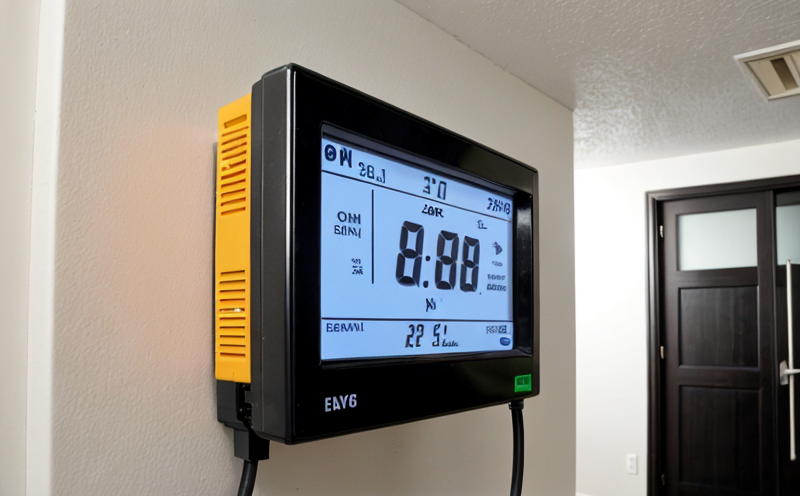ISO 13153 Energy Efficiency Testing of Building Systems
The ISO 13153 standard provides a comprehensive approach to testing and assessing the energy efficiency of building systems. This service is crucial for quality managers, compliance officers, R&D engineers, and procurement teams involved in the design, construction, and operation of buildings that aim to meet stringent environmental and sustainability targets.
The standard focuses on evaluating the performance of various components within a building system, including HVAC (Heating, Ventilation, and Air Conditioning) systems, lighting fixtures, insulation materials, windows, doors, and other energy-consuming elements. The goal is to ensure these systems operate efficiently and contribute positively to the overall energy efficiency of the structure.
Compliance with ISO 13153 is essential for obtaining international recognition and certification, which can significantly enhance a company's reputation in the global market. This standard ensures that building systems are not only functional but also optimized for minimal energy consumption. By adhering to these guidelines, organizations can reduce operational costs, improve environmental performance, and meet regulatory requirements.
The testing process involves several key steps, including the selection of appropriate test specimens, calibration of instruments, setup of controlled environments, and execution of standardized procedures. Each step is meticulously documented to ensure reproducibility and accuracy of results. The outcome provides actionable insights that can be used for continuous improvement in building design and operation.
For HVAC systems, testing typically involves measuring energy consumption under various load conditions, analyzing airflow patterns, checking the efficiency of compressors and fans, and ensuring proper insulation levels. Lighting fixtures are evaluated based on luminous efficacy, power factor, and thermal performance. Insulation materials undergo tests to determine their R-values (thermal resistance), while windows and doors are tested for air leakage rates and solar heat gain coefficients.
The ISO 13153 standard also emphasizes the importance of considering interactions between different building components during testing. For instance, the efficiency of an HVAC system might be significantly impacted by the type of insulation used or the quality of windows installed. Therefore, comprehensive testing ensures that all aspects are optimized for maximum energy savings.
By leveraging this service, organizations can demonstrate their commitment to sustainable practices and ensure they meet the highest standards in building energy efficiency. This not only enhances market competitiveness but also contributes positively towards reducing carbon footprints.
- Selection of appropriate test specimens
- Calibration of instruments
- Setup of controlled environments
- Execution of standardized procedures
This holistic approach to energy efficiency testing ensures that buildings are not only constructed with sustainability in mind but also operated efficiently throughout their lifecycle.
Applied Standards
The ISO 13153 standard is widely recognized and applied across various sectors, including commercial real estate, residential construction, government buildings, and educational institutions. It aligns with other international standards such as EN ISO 5208 for building energy performance and ASHRAE Standard 90.1 regarding energy-efficient design of buildings.
By adhering to these guidelines, organizations can ensure that their buildings meet the highest levels of energy efficiency and sustainability. The standard provides a framework for evaluating various components within a building system, ensuring they operate efficiently and contribute positively to the overall energy performance of the structure.
Benefits
The benefits of ISO 13153 energy efficiency testing extend beyond compliance; it offers numerous advantages that can significantly impact an organization's operations and reputation. Here are some key benefits:
- Cost Savings: By identifying inefficiencies early in the design or operational phase, organizations can implement cost-effective solutions to improve energy performance.
- Environmental Impact: Reducing energy consumption directly contributes to lower greenhouse gas emissions and supports sustainability goals.
- Regulatory Compliance: Ensuring adherence to international standards helps avoid potential penalties associated with non-compliance.
- Market Differentiation: Demonstrating leadership in sustainable practices can enhance an organization's reputation, attracting environmentally conscious customers and partners.
In addition to these tangible benefits, organizations that invest in ISO 13153 testing also experience intangible advantages such as enhanced stakeholder confidence and improved brand perception. These factors collectively contribute to long-term success and sustainability within the industry.
International Acceptance and Recognition
The ISO 13153 standard enjoys widespread international acceptance across numerous countries including the United States, Canada, Europe, Asia-Pacific regions, and many others. Its broad recognition is attributed to its robust framework for evaluating energy efficiency in building systems.
- United States – ASHRAE has aligned its guidelines with ISO 13153
- Canada – The National Energy Code of Canada (NEC) references this standard
- Europe – Several countries, including Germany and the UK, have incorporated ISO 13153 into their national regulations
- Australia and New Zealand – Both regions reference ISO standards in their building codes
The consistent application of these internationally recognized guidelines ensures that buildings around the world are evaluated using a uniform approach, promoting fair comparisons and enhancing global marketability.





